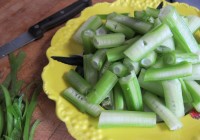//
-
Freshly cut pokeweed stems
https://www.ediblemanhattan.com/wp-content/uploads/2011/06/Pokweed-stems1.jpg
-
Pokeweed stems, prepped
https://www.ediblemanhattan.com/wp-content/uploads/2011/06/Pokeweed-stems.jpg
-
The start of the pokeweed scramble
https://www.ediblemanhattan.com/wp-content/uploads/2011/06/The-start-of-the-pokeweed-scramble-on-toast.jpg
-
The plated pokeweed scramble, on Wonderbread
https://www.ediblemanhattan.com/wp-content/uploads/2011/06/The-pokeweed-scramble.jpg
// <
‘);
tid(‘spinner’).style.visibility = ‘visible’;
var sgpro_slideshow = new TINY.sgpro_slideshow(“sgpro_slideshow”);
jQuery(document).ready(function($) {
// set a timeout before launching the sgpro_slideshow
window.setTimeout(function() {
sgpro_slideshow.slidearray = jsSlideshow;
sgpro_slideshow.auto = 1;
sgpro_slideshow.nolink = 0;
sgpro_slideshow.nolinkpage = 1;
sgpro_slideshow.pagelink=”blank”;
sgpro_slideshow.speed = 5;
sgpro_slideshow.imgSpeed = 10;
sgpro_slideshow.navOpacity = 80;
sgpro_slideshow.navHover = 70;
sgpro_slideshow.letterbox = “#FFFFFF”;
sgpro_slideshow.info = “information”;
sgpro_slideshow.infoShow = “S”;
sgpro_slideshow.infoSpeed = 10;
sgpro_slideshow.left = “slideleft”;
sgpro_slideshow.wrap = “slideshow-wrapper”;
sgpro_slideshow.right = “slideright”;
sgpro_slideshow.link = “linkhover”;
sgpro_slideshow.gallery = “post-19239”;
sgpro_slideshow.thumbs = “thumbslider”;
sgpro_slideshow.thumbOpacity = 70;
sgpro_slideshow.thumbHeight = 75;
// sgpro_slideshow.scrollSpeed = 5;
sgpro_slideshow.scrollSpeed = 0;
sgpro_slideshow.spacing = 5;
sgpro_slideshow.active = “#DDDDDD”;
sgpro_slideshow.imagesbox = “window”;
jQuery(“#spinner”).remove();
sgpro_slideshow.init(“sgpro_slideshow”,”sgpro_image”,”imgprev”,”imgnext”,”imglink”);
}, 1000);
tid(‘slideshow-wrapper’).style.visibility = ‘visible’;
});
// ]]>
Thinking thoughts innocent of foraging, I strolled down the broad mown grass path to Brooklyn’s Dead Horse Bay recently, focused instead on gathering old glass bottles to hold my summer’s haul of juneberries in gin. But in the shade of some wild cherries a stand of tall greens stopped me. Was it pokeweed, Phytolacca americana? Broad, tender leaves; smooth, fat stems. My husband lent me his pocket knife and I sliced as many stems as I could, stripping off the leaves and using one of the bags we had brought to hold salvaged bottles. My day was made.
This is the thrill of the forager: There is food wherever you go.
At home, after visiting my books, much of the Internet and emailing an experienced eater of wild foods, who confirmed their identity, I prepared the pokeweed stems by stripping off their thin skin. No red was visible, the part of the plant that contains toxins along with the roots, the mature leaves and the uncooked berries. The pokeweed was young, my stalks maxing out at 12″. All good. I did as I was told and blanched the sliced stems thrice–boil, blanch, refresh, repeat. Surprisingly, they retained their shape and texture well.
(To avoid those toxins, experienced foragers recommend the latter routine and eating only those green, young late spring or early summer shoots, which must be cooked. You can also boil the berries that appear later in the year into jelly, but more on that in September.)
In the South pokeweed–also known as polk salat, poke or inkberry–used to be eaten with bacon drippings, though the practice of eating the plant has fallen by the wayside in recent years. My kind of food. I cooked some thin pancetta till the fat ran, added my pokeweed pieces, some finely grated parmesan, and at the last minute cracked a couple of eggs over the top. And then…I loaded it onto slices of Wonderbread. It comes over me once a year: A desire for Wonderbread, and it was a defiant and guilty marriage of uberlocal potherb with contralocal loaf. It was great. (See the recipe at my blog, 66 Square Feet (the Food).)
Falling somewhere in the realm of asparagus meets artichoke meets cooked cucumber, this is a wayside vegetable that I will pounce on again as soon as I have the chance. Next time I’ll gratinate it. And serve it at dinner with real silverware and candles and courses before and after. And if someone would lend me an Airstream, I’ll travel South to a pokeweed festival and happily dive in at the deep end.
(Editor’s Note: Foraging, Viljoen-style, is one way to win our Eat Drink Local Week Challenge.)



 la
la la
la la
la la
la